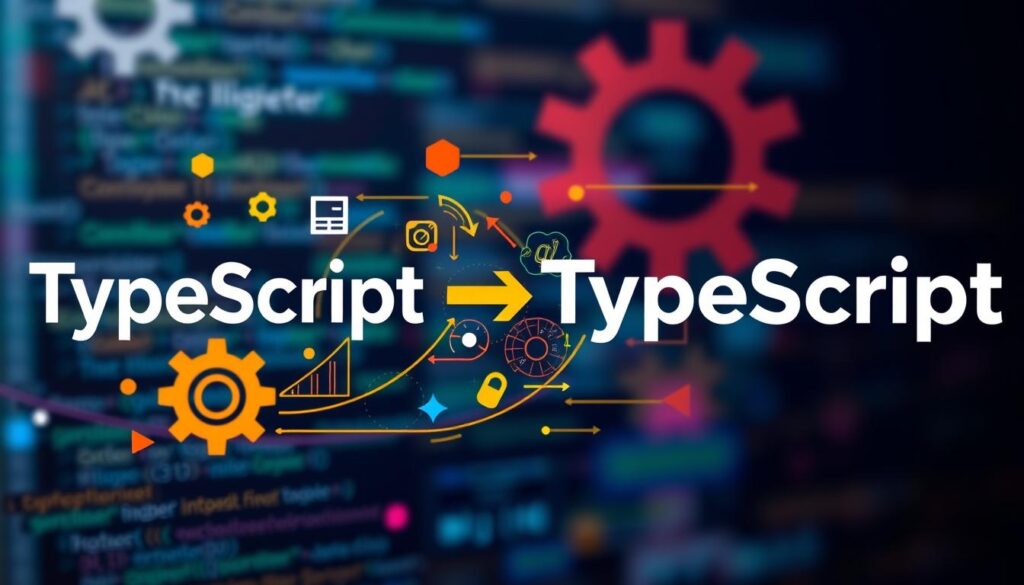
Did you know big names like Google and Asana have switched to TypeScript? This shows how much of an impact it has on coding. TypeScript is changing the game by making code better and working with JavaScript.
TypeScript is a big deal in tech. It’s like JavaScript on steroids. Version 5.3 brings new features like better import handling and improved type safety. These changes make coding easier and apps more reliable.
Exploring TypeScript’s journey shows its importance in today’s coding world. TypeScript focuses on static typing for better stability and fewer bugs. It makes coding smoother and more efficient.
Key Takeaways:
- TypeScript 5.3 adds stable support for resolution mode in import types, boosting module resolution flexibility.
- Enhancements in TypeScript 5.3 improve type safety, particularly in conditional statements.
- Large companies like Google and Asana have adopted TypeScript for their major projects.
- TypeScript seamlessly integrates with leading frameworks like Angular, React, and Vue.
- The language’s static typing helps catch bugs early, reducing critical issues in production.
- With its open-source nature, TypeScript continuously evolves through community-driven contributions.
What is TypeScript
TypeScript is a tool that makes JavaScript better by adding static typing. This helps find mistakes early, making our code stronger and easier to keep up. The TypeScript type system also helps large projects stay organized. It works with both new and old JavaScript versions, keeping your code running smoothly everywhere.
TypeScript’s Genesis
Microsoft introduced TypeScript in October 2012, led by Anders Hejlsberg. It was made to solve JavaScript’s problems with big projects and error checking. Since then, TypeScript has grown, adding features like generics and async support for today’s developers.
Key Features of TypeScript
TypeScript makes JavaScript better with optional static typing and more. It supports object-oriented programming, making big apps easier to manage. The TypeScript compiler also helps, offering fast compilation and great IDE support.
- Advanced type system: interfaces, enums, generics, access modifiers
- Compatibility with modern JavaScript: async/await, decorators, and more
- Rich IDE support for real-time type information
- Static typing to catch type errors during compilation
- Works seamlessly with popular frameworks like React, Angular, and Vue.js
TypeScript vs JavaScript
JavaScript is dynamic, but TypeScript adds type support to find errors early. This makes code better and development smoother. At first, TypeScript might seem hard to learn. But, its benefits are huge, making it a top choice for many.
TypeScript is great with Node.js and GraphQL too. It keeps data consistent throughout your project.
An Overview of TypeScript Features
TypeScript is a key player in web development, thanks to its core TypeScript features. We start with its static typing system. This feature boosts code quality and makes developers more productive.
Static Typing
TypeScript’s static typing is a standout feature. It lets developers check types before running the code. This helps catch bugs early, making code better and safer.
With TypeScript, you get tools like code completion and refactoring. These tools make coding easier and faster.
Switch (true) Narrowing
TypeScript 5.3 brings switch (true) narrowing. This upgrade makes type handling in case statements more precise. It lets developers write cleaner, error-reduced code.
This feature is part of TypeScript’s goal to make coding safer and more efficient.
Import Attributes and Resolution Mode
TypeScript has also added TypeScript import attributes. These attributes make importing modules easier by adding metadata. They support different module systems like CommonJS and ES.
This update makes TypeScript more flexible and efficient. It aligns with ECMAScript standards and improves module management.
TypeScript’s continuous updates show its value to developers worldwide. It offers advanced features and a smooth development experience.
The Evolution of TypeScript
Since its start, TypeScript has changed a lot. This change came from new ideas and help from the community. Let’s look at the main changes in TypeScript and how the community helped it grow.
Version History
The history of TypeScript shows its fast growth:
- October 2012: TypeScript first came out with version 0.8. It began after two years of work at Microsoft.
- April 2014: TypeScript 1.0 was shown at Microsoft’s Build conference.
- September 2016: Version 2.0 made TypeScript safer by adding null safety.
- July 2018: TypeScript 3.0 added new features like tuples in rest parameters.
- August 2020: TypeScript 4.0 included Custom JSX Factories and Variadic Tuple Types.
- March 2023: TypeScript 5.0 supported decorators, making it even more useful.
TypeScript is connected to languages like C#, F#, Java, and ActionScript. This connection makes it flexible and strong over time.
Community Contributions
The TypeScript community contributions have been key to its growth. The community has added type definitions for many JavaScript libraries. This makes TypeScript work well with other JavaScript projects. Some big contributions are:
- Declaration Files: Developers have made declaration files. These files act as interfaces to JavaScript components, helping with third-party use.
- Type Inference: TypeScript’s compiler guesses the types of variables. This makes coding easier and more precise.
- Union Types and Type Checking: Union types help make code more reliable. They use typeof and instanceof calls to check types.
| Version | Release Date | Key Features |
|---|---|---|
| 0.8 | October 2012 | Initial Release |
| 1.0 | April 2014 | First Stable Release |
| 2.0 | September 2016 | Null Safety |
| 3.0 | July 2018 | Tuples in Rest Params, Spread Expressions |
| 4.0 | August 2020 | Custom JSX Factories, Variadic Tuple Types |
| 5.0 | March 2023 | Support for Decorators |
In summary, both official updates and community help have shaped TypeScript. This shows its steady and important growth in web development.
Benefits of Using TypeScript
Choosing TypeScript offers many benefits to developers. It boosts productivity and improves code quality. Let’s dive into these advantages.
Enhanced Code Quality
TypeScript stands out for its ability to enhance code quality. It does this through static type checking. This means errors are caught early, making the code more stable and easier to maintain.
It leads to code that is easier to understand and document. Big names like Google’s Angular, Asana, and Slack use TypeScript for these reasons.
Reduced Debugging Time
With TypeScript, developers spend less time fixing bugs and more on adding new features. Studies show TypeScript catches up to 15 percent of common bugs early. This prevents runtime errors, making development smoother.
Tools like Visual Studio Code by Microsoft make working with TypeScript easier. This improves code quality and reduces debugging time.
Improved Development Workflow
TypeScript also makes development workflows better. It’s supported by many IDEs, offering smart code help and refactoring tools. This support leads to faster, more efficient development.
TypeScript works well with React for the frontend and Node.js for the backend. Its cross-platform and cross-browser compatibility makes it a top choice for web and mobile app development.
| Benefit | Impact |
|---|---|
| Enhanced Code Quality | Stable and maintainable codebase, early error detection, self-documenting code |
| Reduced Debugging Time | Up to 15 percent error detection at compile stage, less runtime issues |
| Improved Development Workflow | Efficient development, supported by multiple IDEs, cross-platform and cross-browser compatibility |
Understanding TypeScript’s Type System
TypeScript’s type system adds predictability and discipline to JavaScript. It includes basic types like string, number, and boolean. Special types like any, null, undefined, and void also play a role.
The any type offers flexibility but requires caution. The void type is useful for functions without a return value.
Basic Types
TypeScript’s basic types are similar to JavaScript’s primitives. It includes string, number, and boolean. Arrays in TypeScript can be specific types, like number[] or Array.
Using type annotations makes code clearer and easier to maintain. The noImplicitAny compiler flag helps avoid implicit any types. Union types, marked by |, allow variables to hold multiple types.
Advanced Features: Generics and Enums
Generics in TypeScript make functions and classes work with different data types safely. They enforce constraints for type safety and code reusability. Enums help define named constants, making code cleaner and easier to read.
Enums can represent related values, like directions in a navigation system. Intersection types allow combining features from different objects. This makes TypeScript’s type system more robust.
Static Typing Benefits
TypeScript’s static typing is a major advantage. It catches type errors early, not at runtime. This saves a lot of debugging time and makes development smoother.
Static typing also makes code refactoring safer. It ensures changes don’t break existing code. Thanks to community contributions, TypeScript’s type system keeps improving, offering resilience and efficiency.
FAQ
What is TypeScript?
TypeScript is a version of JavaScript that adds static typing. It was made by Microsoft. It helps make large JavaScript apps better by catching errors early.
How did TypeScript originate?
Microsoft showed off TypeScript in October 2012. Anders Hejlsberg, who made C#, led its creation. It was made to help JavaScript handle big apps better.
What are the key features of TypeScript?
TypeScript has features like static typing and type annotations. It also supports frameworks like Angular and React. New features include better handling of switch statements and import metadata.
How does TypeScript compare to JavaScript?
JavaScript is a dynamic language for web apps. TypeScript adds static typing to JavaScript. This makes TypeScript great for big, complex apps.
What are the benefits of static typing in TypeScript?
Static typing in TypeScript means checking types before running code. This reduces errors and makes coding better. It helps with code completion and finding errors early.
What is switch (true) narrowing in TypeScript?
Switch (true) narrowing is a new feature in TypeScript 5.3. It makes sure switch statements are typed correctly. This makes code more reliable and predictable.
What are import attributes and resolution modes in TypeScript?
TypeScript 5.3 added import attributes for metadata. It also improved how modules are found, making them work better together. This makes coding more precise and efficient.
How has TypeScript evolved over time?
TypeScript has grown a lot since it started. It now has features like generics and support for new JavaScript standards. A dedicated community keeps improving it.
What role do community contributions play in TypeScript’s development?
The TypeScript community is key to its growth. They add type definitions for many JavaScript libraries. This makes TypeScript more adaptable and widely used.
What are the main benefits of using TypeScript?
TypeScript improves code quality and reduces debugging time. It also makes coding faster with tools like code completion. These benefits make coding more efficient and reliable.
How does TypeScript improve development workflow?
TypeScript’s typing and tools like code completion make coding smoother. Developers can work faster and catch bugs early. This streamlines the development process.
What is covered within TypeScript’s type system?
TypeScript’s type system includes basic types like booleans and numbers. It also has advanced types like enums and generics. These features make code better and more efficient.
What are generics and enums in TypeScript?
Generics in TypeScript let developers create flexible components. Enums help define named constants, making code cleaner and easier to maintain.
Future App Studios is an award-winning software development & outsourcing company. Our team of experts is ready to craft the solution your company needs.










